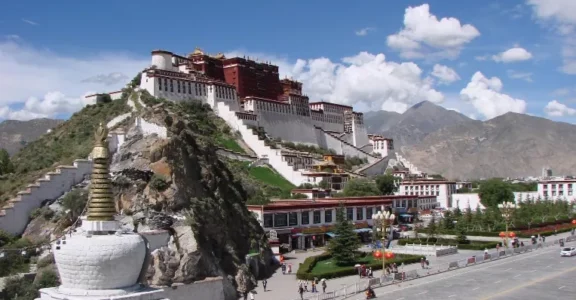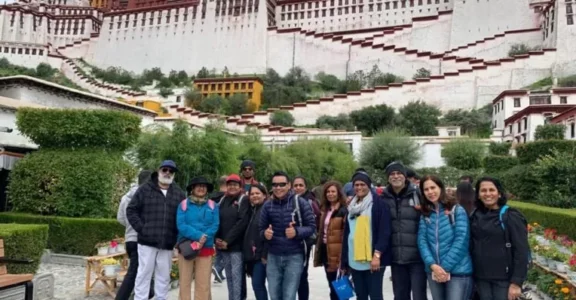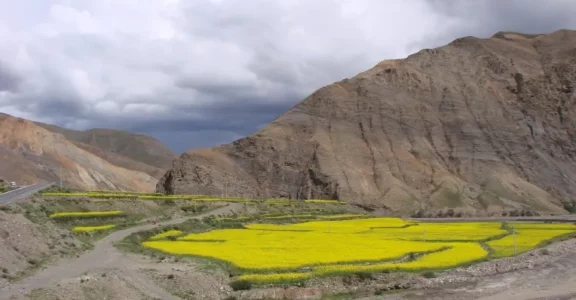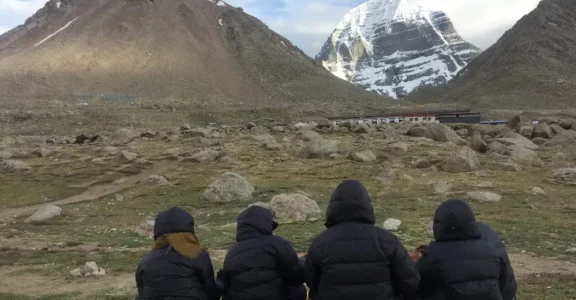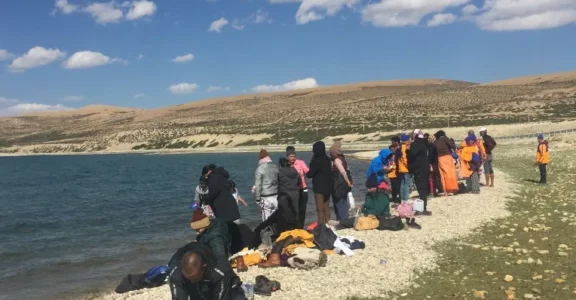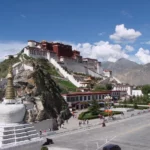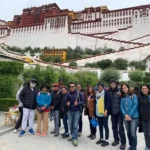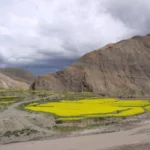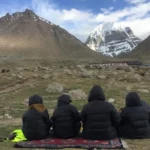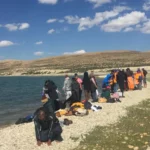132 reviews in 
US$ 3150
Per Person (Group Size: 5 - 55)
- Best Price Guarantee
- Secure Online Booking
- Flexible Booking Dates
- Decades of experience in Trekking
Group Discounts
If you have question about Kailash Yatra Via Lhasa-18 Days, please fell free to ask
At a Glance
Destination
Tibet, ChinaTrip Difficulty
DifficultMax altitude
5600m /18372 ftGroup Size
5 - 55 Pax.Activity
Driving -Hiking - sightseeingAccommodation
Hotel in Kathmandu, & Lodge / Gusthouse in YatraMeals
Breakfast, Lunch & DinnerVehicle
Private car \ jeep , bus and flightOverview of Kailash Yatra Via Lhasa-18 Days
Kailash Yatra Via Lhasa-18 Days is one of the most popular yatra among adventure lovers from around the world. Do you want to transform yourself, leap into infinity, and leave the karma of your past and this life behind, then welcome to our Mt. Kailash Yatra via Lhasa tour. This is an opportunity to touch the most sacred place, bow to Mahadev, receive spiritual gifts, and energy for deep transformation.
However, our Kailash Yatra is not only a spiritual journey, but it is also a remote tour in Nepal and Tibet that attracts numerous adventure travelers and nature lovers. The spectacular Kora hike and the unique landscape with the breathtaking Manasarovar Lake have been the main magnet that keeps attracting numerous Western travelers every year.
At 6,638m high, Kailash Parvat (Mountain) is located north of the intersecting point of the western border shared by China, India, and Nepal. Revered by Hinduism, Buddhism, Jainism, and Bon, Mount Kailash is often referred to as the Temple of Temples, Axis of the Universe, or Heart of the World.
In Hinduism, the holy mountain is regarded as the favorite home of Lord Shiva- a destroyer of bad Karma and illusions. It is believed he spends his days practicing yoga and meditation with his divine family of Goddess Parvati, Lord Kumar, and Lord Ganesh along with his Ganas (retinues).
Numerous reports have emerged stating the sound of Shiva’s Damaru (two-headed drum) along with the resonance of OM is heard continuously around Mount Kailash and Lake Mansarovar.
Different Vedic scriptures such as Ramayana, Mahabharata, Shivapurana, Shankharpurana, Machchepurana, and Vishnupurana have mentioned Kailash. According to Vishnu Purana, Kailash has four sides representing four faces of Lord Shiva and they are made of gold, crystal, gem, and silver.
Everything here manifests the Lord, his presence, and his blessings. Therefore, many yogis and sincere seekers of truth have spent many years here in meditation and prayer seeking blessings from Lord Shiva.
While it holds significance in Hinduism, it is equally important in Buddhism, Jainism, and Bonism. Buddhist pilgrims believe Kailash to be the holy abode of Buddha in Samvara’s incarnation. Jains revere Kailash as the place where their first saint achieved liberation. For followers of the Bon tradition, Mount Kailash is the heart of the ancient country of Zhang Zhung, where Bon originated.
From the practical point of view, Kailash has four faces, oriented almost exactly to the cardinal points, and therefore resembles a pyramid. The southern face is neatly cut in the middle from the top to the bottom by a straight, even crevice. In the middle, another crack intersects it at a right angle. This whole structure resembles Swastika a symbol of Spiritual Power and it is visible from tens of kilometers away!
Near Mount Kailash is the sacred Lake Mansarovar. According to Tibetans, the lake was consecrated by the Buddha himself, so walking around it brings positive energy. Hindus believe the lake is the soul of God Brahma and it is where God Mahadev and goddess Parvati swam. The lake is shaped like an eight-petalled lotus and lies in a valley at an altitude of 4485 m above sea level.
Because of this religious and spiritual importance and is considered the largest Energy Hub, thousands of pilgrims and travelers join the Kailash Mansarovar Yatra to make a circuit ( Kora/Parikrama) around the sacred Mount Kailash. The pilgrims tend to do the parikrama on the full moon like Jestha (May/June), Janaipurnima in Shrawan (July/August), and Bhadra (August/September) to wash away the bad karma of the past 100 lives.
It is believed taking a holy bath with Lake Mansarovar water and performing a spiritual ritual in the name of deceased ancestors will provide their souls the eternal liberation. Therefore, the best season to visit Kailash is the months from May to November. There is a pleasant climate here.
Come and join us for we will together finish this energetic spiritual journey. Remember, this sacred Mt. Kailash Yatra has a place for people of all castes, nationalities, religions, and professions. Everyone will receive what they need.
Mt. Kailash Yatra from Nepal
Although feasible from India and China, the Mt Kailash yatra from Nepal is very popular. There are several options from Kathmandu to Mount Kailash:
- Overland route from Kathmandu to Mount Kailash via Kerung:
Since the Chinese Government has opened its border from Kerung, it is another option to cross Tibet from Nepal. We will drive to Syabrubesi, and drive to Kerung.
After a stopover in Kerung, we drive to Darchen with a stop in Saga. The next day we will drive past Paryang and experience the beautiful Mansarovar Yatra Lake and finally reach the idyllic village of Darchen at the foot of Mount Kailash. From here we can easily reach the well-known hiking routes around the holy mountain.
- Kailash Helicopter Tour via Simikot
This is a faster but expensive option to reach Mount Kailash. We will fly to Nepalgunj, and Simikot airport from where we will fly in a small helicopter to Hilsa. A small road trip will take you to Taklakot where we will spend a night for acclimatization. The next day we drive to Darchen for Kailash Parikrama and trek to Dirapuk to ZhutulPuk over Dolma-La Pass.
Then ending the Kailash Yatra, we drive to Taklakot and fly to Nepalgunj and Kathmandu.
- Overland Tour of Mount Kailash with a flight to Lhasa
This option is the most popular route to take which we will be opting for according to our program. We will combine a two-hour flight from Kathmandu to Lhasa then continue with an overland tour experiencing the impressive Tibetan landscape and the opportunity of exploring several renowned Tibetan monasteries.
From Lhasa, we drive to Xigatse via Gyantse, Saga, Lake Mansarovar, and Darchen and begin our trek to Dirapuk. Accomplishing the outer and inner Kora, we hike to cross Dolma La Pass, ZhutulPuk, and Darchen and drive to Saga.
Concluding our journey, we drive to Lhasa along the Friendship Highway to take a return flight to Kathmandu.
How does our journey begin?
Our Mt. Kailash Yatra via Lhasa begins upon your arrival in Kathmandu. We will spend three days in Kathmandu where we will visit Pashupatinath and perform Puja, receive blessings, Swayambhunath, and various other significant temples of the city. After preparing for the trip, we take a flight to Lhasa- Tibet Capital. The day is spent with acclimatization and another day will be used to explore Lhasa.
We will then drive to Xigatse and Saga the next day where we will spend another acclimatization day. From Saga, we will head to Lake Manasarovar and Kailash. We will perform Kora around the sacred lake.
We will climb to the foot of Kailash to have a special darshan of Shiva. The climax of our journey is Kora – a walk around the sacred mountain that takes 3 days. The highest point is the Dolma La pass, after finishing the kora, we get back to Nepal in 3 days by land via Xigatse and Lhasa.
Our Trip Route
Arrival in Kathmandu → 3 (4) days stay in Kathmandu → Fly to Lhasa → Lhasa Acclimatization → Drive from Lhasa to Xigatse → Drive to Saga → Drive to Lake Manasarovar → Drive to Darchen → Drive to Yamadawar and Trek to Dirapuk → Inner Kora → Trek to ZhutulPuk over Dolma-La Pass → Trek back to Darchen and Drive back to Saga → Drive to Xigatse → Drive Back to Lhasa → Fly to Kathmandu → Departure
Attraction of our Trip
Our Mt. Kailash Yatra via Lhasa includes three extra days in Kathmandu which we will use to explore the significantly important historical and holy landmarks of the city.
First, we will visit the main Hindu temple of Pashupatinath located west of Kathmandu along the Bagmati River. The temple is known for its beautiful pagoda-style architecture, covered in bronze and gold.
The temple is dedicated to Pashupati, one of the incarnations of Shiva. Of the three gates, only the western gate is open, and only South Asian Hindus are allowed inside. A good viewpoint of the complex for non-Hindus is on the other side of the river.
During our visit, we will perform Rudravishek (special puja of Shiva) with Brahmin to seek blessing for the successful completion of the Kailash Yatra.
After Pashupatinath, we will visit Swayambhunath (Monkey Temple) located on a hilltop in western Kathmandu. The Swayambhu stupa, painted with the eyes of the omnipresent god, forms the center of the temple complex. The temple complex is said to be from 5th century.
We will also take a tour of Kailash Mahadev in Sanga which is considered the tallest statue of Mahadev in Nepal. Then we will visit Doleswor Mahadev- known to be the head part of Kedarnath in India.
Next on our list is Boudhanath Stupa situated just outside Kathmandu. It is one of the largest of its kind in the world and dates back to around the 6th century, possibly even earlier. The stupa itself is a symbol of enlightenment but at Boudhanath, the symbolism is especially clear.
Each different shape represents one of the five elements, earth, water, fire, air, and sky, which are also attributes of the five Buddhas. Gathered in the form of stupas, their unity abstractly reflects the structure of the universe itself.
Our next stop in Kathmandu will be the famous Budhanilkantha temple located in the village of Narayanthan, around 15 kilometers north of the city center of Kathmandu. The temple, located at an altitude of around 1,450 meters, whose extraordinary atmosphere is also created by the many butter lamps and incense, is overlooked by the peaks of Shivapuri, which forms the northern edge of the Kathmandu Valley.
One of the most important Hindu statues in Nepal, the sleeping Vishnu, can be viewed here. The statue probably dates from the 7th or 8th century.
2. Mansarovar Lake
Our Mt. Kailash Yatra will also lead us to the holy water of Lake Mansarovar which is an equally important site for pilgrims from Nepal, India, Tibet, and all around the world. It is one of the four sacred lakes of Tibet. Hindus believe that to get rid of sins, you need to bathe in the sacred Lake Manasarovar.
Tibetans consider this a desecration of the great Shrine and only wash their faces with sacred water or drink water from the lake. They believe this act will cleanse them of sinful thoughts and intentions, and also heal physical ailments.
3. Mt. Kailash (south and north both sides visit)
Our designed program will take you to both the northern and southern face of Mount Kailash. Once we reach Dirapuk Monastery, we will see a majestic view of the northern wall of Kailash. A narrow path between the mountains will take us to Kailash. We will spend one extra day for north and south parikrama of Kailash.
In addition to the outer Kora, we will also perform an inner kora near Mount Kailash. It is shorter than the outer Kora but more challenging and dangerous as it goes through high passes and rocks. We will walk along the path running along the Lhachu River valley along the western face of Kailash. We will set foot on Asthapath, visit Serlung Gumba, Saptarishi cave, Atmalingam, and view the southern face of Mount Kailash.
According to Tibetan beliefs, you can take this route only after you have passed the main outer Kora at least 13 times. The inner Kora is not allowed for international travelers.
4. Tirthpuri
In addition to outer and inner Kora, if time permits and we have energy left, we can also undertake a kora at Tirthpuri and visit its monastery where Padmasambhava meditated. Here, the breath of ancient Tibet is still alive in this beautiful, classic pilgrimage site with its hot sulfur springs.
For Tibetan believers, in addition to circumnavigating Mount Kailash and Lake Manasarovar, visiting the holy place of Tirthapuri is also an important part of a pilgrimage. You visit the meditation places of Padmasambhava (Guru Rinpoche) and have enough time for a soothing bath in the sulfur springs of the place.
5. Mountain Views
During Mt. Kailash Yatra, we will also be able to enjoy some magnificent views of the grand icy white mountains both in Kathmandu and Tibet. While in Kathmandu, you can marvel at the spectacle of great mountains such as Langtang Lirung, Dorje Lakpa, Jugal Himal, Ganesh Himal, Annapurna, and also Everest.
During the two-hour panoramic flight to Lhasa, you will fly over Kanchenjunga and Everest. while along the Tibetan route, you will able to see Everest, Cho Oyu, Shishapangma, Gaurishankar, Langtang, and many other Tibetan Peaks.
6. Wildlife, flora and fauna
Mt. Kailash Yatra is equally known for its unique flora and fauna appreciated by nature lovers. Here you can see a large number of unusual bird species, flowers, and wildlife. Mostly along the route, you will encounter Saussurea commonly known as bitterberry. Wild allium grows near streams and cascading waterfalls.
Mount Kailash itself is also a paradise for different species of animals such as wild donkeys, Tibetan antelopes, yaks, swans, black-necked cranes, and many others. The specific wild donkey residing in the area is of Kiang breed which is the largest wild donkey in Tibet.
The Tibetan antelopes found here are considered the sacred unicorns of Tibet. They have a thick undercoat and dense coat as temperatures often drop below zero. They are categorized as the protected animals in China therefore Sanjiangyuan National Nature Reserve has been established for their protection.
Another rare species found in the Kailash region is the black-necked crane which is also considered a holy bird as they are quite popular among Tibetans who practice Buddhism. These birds migrate to Tibet to spend winter, if you happen to travel to Tibet in this season, you will be able to see their flocks in the meadows.
In addition to the above-mentioned animals, you can also find other fauna here, such as gazelle, Tibetan long-horned antelope, or water pigeon.
Highlights of Kailash Yatra Via Lhasa-18 Days
- Enjoy the two-hour scenic flight to Lhasa
- Immersion in the impressive beauty of Tibet
- Exploration of Potala Palace, Jokhang Monastery, Barkhor Market, Norbulingka Palace, and Drepung Monastery
- Darshan of the most revered mountain on Earth, the Pyramid of the Gods Mount Kailash.
- Enormous spiritual experience through Yatra or Parikrama of Kailash
- Religious bath in the sacred water of Lake Mansarovar
- Experience the manifestation of Lord Shiva everywhere in everything
- Deep Meditating opportunity in the pristine environment of Kailash
- Complete transformation into another being free of all sins from past and present life
- Adventurous crossing of the highest point – Dolma La pass at an altitude of 5630 m
- Deep spiritual indulgence in the city of temples- Kathmandu with a visit to
- Pashupatinath and Puja, Budhanilkantha, Doleshwor, and Kailash Mahadev Temple
Itinerary
01
Day 01 Arrive in Kathmandu and Transport to your Hotel. (Alt.1300m)
You arrive in Kathmandu- Nepal’s capital today. Our guide will warmly receive you at the airport exit gate and together you will head to the hotel located in the center of the city.
After some rest, you can walk to the nearest attractions, getting acquainted with the history and culture of the Nepalese people. In the evening, you can enjoy a delicious dinner at a restaurant serving different national cuisines.
Max altitude
1300m/4266 ftMeals
Breakfast, Lunch, DinnerAccommodation
Hotel02
Day 02 Visiting the famous Pashupatinath Temple followed by a Puja
In the morning, our guide will meet you at the hotel and brief you about our Mt. Kailash Yatra program. Then he will lead you to the holiest shrine of Kathmandu- Pashupatinath Temple. It is a famous 5th-century Hindu temple dedicated to Lord Shiva located on the sacred water of the Bagmati River bank.
We will witness the Morning Aarti of the temple which usually takes place at 9 am. Then we will do the Rudrabhishek (worship procedure of Lord Shiva) with the Brahmin and wish for a smooth travel along.
We will also visit other temples in the periphery of the Pashupatinath Temple such as Guheswari Temple dedicated to Goddess Parvati and wife of Lord Shiva.
After some puja and darshan, we will return to our hotel for lunch and rest. Later we can go visit Swayambhunath, Boudhanath, and Durbar Square in Kathmandu.
Max altitude
1300m /4265Ft.Meals
Breakfast, Lunch, DinnerAccommodation
Hotel03
Day 03 Visit the Famous temple in Kathmandu
We will dedicate today also to visiting the famous and significant shrines of Lord Shiva and Lord Bishnu in Kathmandu. First, we will go to Budhanilkantha to worship Jal Narayan also known as sleeping Bishnu. Then we will transfer to Kailashnath Mahadev Temple located in Sanga 20 km away from Kathmandu.
Then we will also take a tour of Dleswor Mahadev temple considered the head part of Kedarnath Shiva of India.
After religious and spiritual renovation, we will return to our hotel and rest.
Max altitude
1300m/4265FtMeals
Breakfast, Lunch, DinnerAccommodation
Local Teahouse04
Day 04 Trip preparation day
Today we will make the necessary arrangements for the Kailash Yatra tour via Lhasa. We will collect your passports and photos to book the flight to Lhasa.
In the meantime, you can rest, and pack your bags. Check if anything is missing, if yes, you can shop around Thamel or other streets of Kathmandu for missing items.
Max altitude
1300m/4265FtMeals
Breakfast, Lunch, DinnerAccommodation
Hotel05
Day 05 Fly to Lhasa. (alt.3650m) 2-hour flight from Kathmandu to Lhasa.
Early morning, we will head to TIA to catch a flight to Lhasa. A 2-hour flight to Lhasa is one of the most beautiful flights in the world flying us above Everest and Kanchenjunga. As we land at the Gonggar International Airport, our local Tibetan crew members will meet us and take us to our hotel in Lhasa.
Since the airport is located 60 km away from the main city of Lhasa, we will have to spend another one and a half hours on the road till we reach our hotel. Please rest and relax throughout the day to acclimatize to the high altitude and temperature.
We will spend another day exploring the beauty of Tibet. Meanwhile, our Tibetan friends will organize a welcome program for us to entertain and learn about the culture of Tibet.
Duration
2 hrsMax altitude
3650m/11975ftMeals
Breakfast, Lunch, DinnerAccommodation
Hotel06
Day 06 Exploration Lhasa (Alt 3650m.)
Have a leisurely breakfast in the morning enjoying the calm atmosphere and incredible landscape of Lhasa. Now, it’s time to go on a full exploration of Lhasa with our experienced Guide who also works as a translator. We will visit Sera Monastery known as the most important monastery and university of Tibet.
We will also take a tour of Jokhang Monastery which is another important pilgrimage point of Tibetan Buddhism. It houses a Buddha statue created during the life of Shakyamuni Buddha. The most important statue in the temple is over 2,500 years old and was consecrated by the Buddha himself.
Next, we will walk along the streets of Barkhor Market enjoying every little detail from street vendors enticing their clients to buy their goods to exhibitions of Tibetan culture, customs, and traditions.
Our next destination is the 17th-century Potala Palace- the winter residence of the Dalai Lama. The Potala Palace was built on the Marpo Ri hill, 130 meters high. From the hill, there is a beautiful view of the whole of Lhasa.
Next on our list is Norbulingka Palace – the summer residence of the Dalai Lama and the most famous garden in Lhasa. The complex is different from most of the monasteries you will see in Tibet. There are several palaces in the park, where the most interesting is the 13th-century Temple of the Dalai Lama.
At the end of the day, we will explore Drepung Monastery – the largest monastery in Tibet, founded in the 14th century. Before the construction of the Potala, Drepung Monastery was the residence of the first 5 Dalai Lamas. During the heyday of Buddhism in Tibet, up to 10 thousand monks practiced in the monastery. Today the number of monks has dwindled to a few hundred (about 600), but Drepung Monastery still shows signs of its former glory.
Max altitude
3650m/11975ftMeals
Breakfast, Lunch, DinnerAccommodation
Hotel07
Day 07 Drive from Lhasa to Xigatse (370km, approx. 7-8 hours)
In the morning after breakfast, we will drive to Shigatse/Xigatse via Gyantse. The asphalt road goes along the huge turquoise mirror of Lake Yamdrok (at 4300 m) and then rises to the Karo La pass (5010 m), where there is an impressive glacier. From here, we are just 90 km away from Xigatse taking us only one and a half hours.
After some rest, we can go to visit the Tashilhunpo Monastery – the residence of the Panchen Lama. Here we can see the relics of Shakyamuni, the Maitreya Hall, and a stunning collection of thangkas.
Duration
7-8 hrsMax altitude
3950m/12959 ftMeals
Breakfast, Lunch, DinnerAccommodation
Hotel08
Day 08 Drive to Saga (460km.) 6-7 Hours
After breakfast, we head to Saga our overnight destination for today. Driving across the pristine Himalayan countryside through the Tibetan plateau, we will reach Lhatse. Here we will stop for lunch and continue on the road through the highest point at the Gyatchu La pass (5220m) along the way, passing Pekutso Lake (4330m), and crossing the Brahmaputra River.
Upon arrival in Saga, we will check in the hotel and spend the night after a delicious Tibetan dinner.
Duration
6-7 hrsMax altitude
4640m/15223 ftMeals
Breakfast, Lunch, DinnerAccommodation
Local Teahouse09
Day 09 Drive from Saga to Lake Manasarovar (500km, 7-8hrs).
After an early morning breakfast, we leave Saga to reach Lake Mansarovar. We will drive through the expanse of Tibet where herds of yaks and sheep graze at Old Dzongba. Continuing our journey on the road, we will reach the Paryang village.
The village is home to a Chinese military base. From here, we will drive on the west to reach the Horchu River. There is a military check post here where we will have our documents checked. Then we will again resume our drive for around 10 minutes and stop for lunch.
Resuming our journey on the road, next, we will cross the Mayumla Pass and reach Lake Mansarovar in about 2 hours.
Duration
7-8 hrsMax altitude
4,590 m (15,060 ft)Meals
Breakfast, Lunch, DinnerAccommodation
Local Teahouse10
Day 10 Puja and Drive to Darchen (4664 m.) 40km
Early in the morning, we will go to bathe in the sacred lake of Mansarovar also known as the water of life. Manasarova is surrounded by Mount Kailash, Swastika Mountain (Gurla Mandhata), as well as the Rakshasatal “dead lake” of Rakshas (demons). on the northwestern bank of the lake is Chiu Monastery associated with the name of Guru Rimpoche (Padmasambhava).
After a sacred bath, we will perform a special pooja of Lord Shiva overlooking Mount Kailash. Then we will also make a kora around the lake which may take 4 to 5 hours. Then we will go visit the Chiu monastery and bathe in its natural hot spring.
After some lunch, we will drive 40 km to the village of Darchen, which serves as a base for pilgrimage around the holy Mount Kailash. The total length of the parikrama/yatra pilgrimage walking route around Kailash is 53 km, which we will cover in three days.
Max altitude
4664m/15301 ftMeals
Breakfast, Lunch, DinnerAccommodation
Local Teahouse11
Day 11 Drive from Darchen to Yamadawar (5km) and Trek to Dirapuk (14km), 5- 6 hours.
This is one of the most exciting days of our Mt. Kailash Yatra tour. We will do the Parikrama/circumambulation of Mount Kailash and have a darshan (visual) of the northern face of Mount Kailash.
But first, we will drive to Tarboche as called by Tibetans, and Yamadwar by Hindus. This place is the entrance gate to begin the holy parikrama of Kailash at an altitude of 15,500 ft. Legend has it that this gate is protected by lord Yama himself (God of Death) and any ill soul cannot pass through this gate.
Once passing this gate/dwar, one will be free from all sins. After Yamadwar, we will begin our trek to Dirapuk lying 12 km away. The path is relatively flat with loose stone pebbles with gentle ups and downs. Reaching Dirapuk, we will have a close view of the Northern face of Mount Kailash. After Darshana, we will rest in our lodge after some light dinner.
Duration
5-6 hrsMeals
Breakfast, Lunch, DinnerAccommodation
Local Teahouse12
Day 12 Exploring the North Side of Mt.Kailash Inner Kora
On this day we will be in close proximity to the Northern Face of Kailash. After some meditation and breakfast, we will go to undertake the challenging inner kora of Mount Kailas through which we can have the Darshana of the Southern face of Kailash. The trail runs along the valley of the Lhachu River along the Western Face of Kailash. This journey is called the inner Kora of Kailash through which you can feel the existence of Lord Shiva all around in everything.
We will complete our parikrama returning to the northern face of Mount Kailash once again. Later, we will have enough time for spiritual practices and further acclimatization to the enormous physical and spiritual heights of these places.
Meals
Breakfast, Lunch, DinnerAccommodation
Local Teahouse13
Day 13 Dirapuk to ZhutulPuk over Dolma-La Pass (Alt 5630 m) Total 22km, generally 11-12 hours
The most difficult, but at the same time sacred day of our pilgrimage to Kailash begins today. Early in the morning probably around 5 am, we will trek to cross the Jarok Donkhang and sky burial site Shiva Tsal (5330m) where as a sign of purification, we will leave old clothes or locks of hair or drops of blood as a wish for a new life. then as will ascend to the pass of Dolma-La.
Then about 5 km steep ascent and the descent will lead us to the mystical lake Gaurikund at an altitude of 5608 m, into the turquoise waters of which Parvati (Gaurimata), the divine wife of Lord Shiva from lord Ganesha her son.
As soon as we reach the top, we will make an offering and conduct meditation on the saddle of the pass. Next, a steep descent will begin along a rocky path, near a rock outcrop called the Axe of Karma where negative karmas are cut off.
By the end of the day, we will arrive at the guest house of the ZhutulPuk monastery, where the great ascetic magician Milerepa performed miracles in ancient times.
Max altitude
5630m/18471 ftMeals
Breakfast, Lunch, DinnerAccommodation
Local Teahouse14
Day 14 Day 14: From Zhutulpuk to Darchen and Drive back to Saga (10 to 11 hrs)
Today, we will receive a blessing, complete the kora, and end our trek. After breakfast, we will hike down to Darchen which lies around 6 km from Zhutulpuk. After about 3 hours, we will be at Darchen from where we will drive back to Saga completing 30% of our journey or parikrama.
At Saga, we will check in at the guest house and rest for the night after a delicious meal
Meals
Breakfast, Lunch, DinnerAccommodation
Local Teahouse15
Day 15 Drive to Xigatse (520km) 6-7 Hours
After breakfast, time to retrace back to Xigatse to rest for the night. We will drive through the familiar road passing the marvelous Himalayan countryside of Tibet.
Duration
6-7 hrsMeals
Breakfast, Lunch, DinnerAccommodation
Local Teahouse16
Day 16 Drive back to Lhasa, 300 km 5 -6 hrs.
We will return to Lhasa through the beautiful Friendship Highway enjoying for one last time the magical splendor of Tibet. In the evening, our Tibetan crew members will organize the farewell program for us.
Duration
5-6 hrsMeals
Breakfast, Lunch, DinnerAccommodation
Local Teahouse17
Day 17 Fly to Kathmandu from Lhasa (2 hours)
After breakfast, we will drive to Gonggar International Airport, and fly to Kathmandu once again enjoying the two-hour scenic flight with beautiful views of Everest and Kanchenjunga. We will drive you to your pre-booked hotel where you can rest and enjoy the charming Nepali nightlife in the evening.
Duration
2 hrsMeals
Breakfast, Lunch, DinnerAccommodation
Local Teahouse18
Day 18 Farewell, departure to your own destination
After breakfast at the hotel, we will transfer you to the airport to board your flight back to your homeland or to your next destination.
Meals
BreakfastAccommodation
Local TeahouseIs this offered itinerary not suitable for you?
Inclusion/Exclusion
What's Included?
- Airport Pickup and drop.
- All means of transportation (by road) depends upon the group size (car,bus,van or jeep).
- Hotel in Kathmandu according to the itinerary.
- Sightseeing and entry fees in Kathmandu(Pashupatinath temple and Swayambhunath temple)
- Lunch and dinner-fully vegeterian meals only.
- Drinking mineral water.
- Sightseeing tour guide.
- Duffle bag for the trip(refundable after the trip).
- Warm down Jacket(refundable after the trip).
- Nature Explore T-shirt as agift.
- China/Tibet travel visa fee.
- All the necessary documents for the trip
- Professional English and Hindi-speaking tour leader.
- Tibet guide and driver.
- All entrance fee during the Yatra.
- Hotel and guest houses during the tour(Yatra).
- All necessary ground transportation by car/jeep/bus.
- Veg food and hot drinks during the tour(Yatra).
- Fresh fruits.
- Sherpa’s Assistant.
- Kitchen staff
- All Government taxes and expenses many more..
Kailash-Tibet side includes.
- Comfortable big tourist bus,jeep(according to the group size).
- Tibet Travel permits and all necessary documents.
- Professional guide and assistance guide according to group size.
- Hotel ,Guest house, and tent during the tour.
- All entrance fees for visiting monasteries,and temples in Kailash-Tibet.
- All necessary equipment.
- Welcome and farewell programs by the Tibet side.
- Airport ,border or any pickup from Tibet entering the place.
- All Tibet-China Gov,vat.Tax etc.
What's Excluded?
- International airfare(Home to Kathamndu-return Home).
- Personal insurance(incase of emergency only).
- Personal trekking and tour gear.
- Kathmandu-Lhasa and return kathmandu airfare.
- Rescue jeep expenses in emergency case only.
- Extra accommodation and food in Kathmandu.
- Horse and helper expenses for while doing Mt.Kailashparikarma(kora).
- Extra snacks & cold drinks.
- Emergency medical expenses at the hospital and return ambulance cost.
- Extra activities in Kathmandu eg:Muktinath Temple tour,Mountain Flight,Manakamana Cable car trip,Pokhara ,Lumbini Tour etc).
- Tipping staff
Departure Dates
| Date | Duration | Price | Availability | Join |
|---|---|---|---|---|
|
Sep 09, 2024 - Sep 26, 2024 |
18 Days | US$ 2799 | 7 seats available | Book Now |
Trip Information
Best Season
When determining the best season for Mt. Kailash Yatra, you need to consider two things: weather and auspicious date. Taking these factors in mind, the best time for mt. Kailash Yatra via Lhasa is in May, June, September, and the first half of October. You will enjoy the incredibly clear blue skies, fresh air, and good visibility, with the temperature averaging around 8 or 9 degrees Celsius.
July and August (rainy season) see half of the rainfall in the entire year. However, constant, continuous rain is rarely seen here. After mid-October, the freezing weather with temperatures around 5°C and winds of more than 20 m/s causes locals to temporarily close their guesthouses or tent camps until next April, marking the end of Mount Kailash Yatra for a year. Mount Kailash is always covered with snow, and Lake Manasarovar often freezes in winter.
So, you can only do the Mount Kailash Yatra from May to October of each year. From a religious point of view, the month of April or May is best for the visit as a month-long Saga Dawa festival is celebrated in Tibet. However, it might be a little crowded as Tibetans from all over Tibet flock to Mt. Kailash.
How to Prepare?
Mt. Kailash Yatra is a demanding trek due to the risk involved in higher altitudes. The weather is quite harsh and unpredictable, the trail consists of numerous steep climbs and descents with the requirement to cross the Dolma-La Pass at 5630 m.
Therefore, you have to prepare well mentally and physically. Swimming, trekking in mountains or hills, jogging, cycling, etc.can help you build a better fitness level and stamina for the demanding trekking.
You can also walk 10 to 15 km every day or three times a week. A simple walk in the park, running, or climbing up and down the stairs can help a lot before participating in Kailash Yatra to restore the energy needed for an adrenaline rush.
At the same time, it is helpful to maintain a cheerful and positive mindset when unexpected difficulties arise. For this, you can practice meditation and some Yoga postures to increase positivity and build up strong mindset.
Difficulty
Undoubtedly, Mt. Kailash Yatra is a spiritually uplifting journey of a lifetime that also offers impressive mountain views. But it is one of the most challenging, demanding, and strenuous tours that take you to some of the high-altitude regions of Tibet prone to changeable mountain weather and requiring tremendous physical exertion.
In addition, you have to overcome some steep climbs for which a hiking pole can be very helpful to keep balance on uneven ground and to help you climb.
The highlight of our Yatra is the Kora itself which begins from Darchen at 4670 m elevation. You will spend the night in Dirapuk Monastery Lodge at an altitude of 5210 m and you will travel through Dolma La Pass at 5630 m which is the highest point of Mount Kailash Kora. The Yatra itself is around 53 km which is a challenge testing your endurance and strength.
Apart from the natural difficulties, there are other challenges you may encounter along the trail. For example, accommodations can be pretty basic with rooms available on a sharing basis. There are no hot shower facilities. There are private toilets but it can be a bit challenging for ladies from the sanitary point of view so bringing toilet paper, wet wipes, toiletries, etc is advisable.
Depending on the time of your Yatra, the accommodation at the monasteries can be full so camping may be needed. Luckily, the monasteries have their own camping ground.
Also, the temperature can quickly change from a pleasant 15 degrees to frosty zero degrees at night. There are electric blankets and multiple sheets available but they tend to be quite dirty so a sleeping bag is a better option.
However, remember, Kailash Yatra is not for comfort but for receiving eternal blessing, liberation from sins, and gaining the most divine experience. So do not let these feeble discomforts block your way towards Kailash.
Altitude Sickness
The 53 km long Mt. Kailash Yatra will lead you to an average altitude of more than 5000 m. Therefore, altitude sickness may be the biggest concern you should think about. However, to ensure you have a safe journey, we have utilized every opportunity to provide you time to acclimate well to the rising altitude.
For the acquaintance with the Nepali atmosphere, you will spend three days in Kathmandu. As you land at Lhasa, you will immediately find yourself at an altitude of 3658 m. Therefore, after the two-hour flight, instead of exploring we will spend the entire day resting. We will stay at Lhasa for two nights – the second day for a full sightseeing program.
We will also stay at Dirapuk for the inner Kora the next day spending night at an elevation of 5210 m. This will prepare us to cross the gigantic Dolma La Pass the following day.
Still, after all these precautions, you may experience loss of appetite, nausea, vomiting, insomnia, dizziness, persistent headache, weakness, fatigue, heavy legs, shortness of breath, and breathing irregularities. These are the first symptoms of altitude sickness.
If you go through these discomforts, please inform our Tibetan guides who will accompany you all along the route and pay close attention to your needs. They will check your pulse and oxygen levels using pulse oximeters. A life-saving hyperbaric oxygen chamber is also kept on Mount Kailash for emergencies.
Try not to pressurize yourself if you suffer from altitude sickness. Please consider descending to a lower altitude or stopping the climb. Otherwise, more serious problems may arise.
Visa Preparation
Since Mt. Kailash is located in western Tibet, we need to apply for travel visas and permits. The needed visas or permits include a China Visa, a Tibet Travel Permit or Tibet Visa, a Foreign Affairs permit, Aline’s travel permit, and a Military Permit.
- Chinese Visa
The Chinese visa to enter the land of China is a requirement for all trips to Tibet. Chinese embassy or consulate provides this Visa. Foreign travelers entering Tibet from Nepal must acquire a Chinese group visa if they want to travel from Nepal to Kailash.
The Chinese Group Visa in Nepal is a single-entry tourist visa issued by the Chinese Embassy in Kathmandu. It is much easier to get a Chinese group visa from Nepal.
We will process the Chinese group visa on your behalf as soon as you arrive in Kathmandu. Processing only takes three days for an express Visa and four days for a normal Visa. We need your valid passport with two photos to apply for this Visa.
- Tibet visa/Tibet Travel Permit
It is the first permit we need to obtain for traveling to Tibet. No matter where you want to travel in Tibet, a Tibet visa is needed. Without a Tibet visa, we will not be able to travel to Mount Kailash. The Tibet Tourism Bureau will issue this Visa and you must book this trip in advance for obtaining the permit.
Once you have booked your tour with us, you have to send us a scanned copy of your passport and photos. then we will apply for the permit on your behalf. All the details including your name, travel time, duration, and itinerary will be printed in the permit.
- Foreign affairs permit
You also need a foreign affairs permit to travel to the sensitive region of Tibet such as Mt. Kailash. Lhasa Foreign Affairs Office will issue these permits for which you need to present your China Visa, Tibet Travel permit, and your passport.
We will process the permit on your behalf before you reach Nepal and the processing time is 10 to 15 days.
- Aline’s Travel Permit
While participating in Mt. Kailash Yatra via Lhasa, we will also be traveling through other UNOPENED AREAS of Tibet such as Xigatse. The other areas include Ngari, Lhokha, Nagchu, Nyingchi, and Chamdo. Therefore, we also need to apply for Aline’s Travel Permit which is issued by the Tibetan Local Public Security Bureau.
The processing for this permit can be done only after you reach Tibet as we need to present your original passport, China Visa, and Tibet Travel Permit. But the issuance duration is just a few hours and it is easy to obtain. Of course, our Tibetan guide will process the permit for you.
- Military Permit
The military permit is issued by the Military Office in Lhasa and it is a must for visiting Mount Kailash. We need your passport, China Visa, and your Tibet visa in order to apply for a military permit for you. Normally it takes 10 to 15 working days. That’s why you have to apply in advance.
- Special permit for Indian Nationalities
For Indian pilgrims or those who use the Indian passport, the rule of the pilgrim is slightly different. The Foreign Office of the Tibet Autonomous Region (TAR), the Tibet Military, the Tibet Border Guard Corps of the Armed Police, and the Public Security Department of the Tibet Autonomous Region issue the Tibet Visa for Indian citizens.
The Foreign Office of the TAR or Pilgrim Center can authorize the Indian pilgrimage to Tibet.
Food and accommodation
We are proud to be your trusted partner for an unforgettable journey to Mt. Kailash. To make your life-changing trip comfortable, we promise to take care of all the logistics and hassle of the trip formalities. Our service has tried to include all aspects of your trip including accommodation and food.
In Kathmandu, we will provide you a comfortable accommodation in a 3-star hotel with shared rooms. If you desire a single room or upgrade your hotel standard, please notify us when reserving your trip. During your stay in Kathmandu, we offer a complimentary vegetarian breakfast each morning.
As our journey to Yatra proceeds further, we make sure your stay in Lhasa, Xigatse, and Saga is also as comfortable as in Kathmandu. Throughout the drive, we will offer completely delicious and hygienic vegetarian meals three times a day with breakfast, lunch, and dinner included. Hot drinks of tea or coffee with each meal and fresh fruits after dinner are also integrated into our service.
From Darchen, our Yatra begins with Kailash. This small town has various accommodation options: from low budget simple guesthouses and simple Tibetan hotels to modern luxury hotels.
When we start Parikrama around the mountain, there are two options available for lodging: main boarding houses and camping. The lodging facilities are available around two monasteries. We will spend the first night in one of the guesthouses near the Dirapuk monastery. On the second night, we will rest in guest houses near the Zhutulpuk monastery.
All guesthouses have very basic amenities with rooms shared between 2, 3, 4, or more people. There are public and private toilets but hot showers or running tap water are unavailable. There are also no electricity in most of the guesthouse but some may have where you can charge your devices.
The guesthouses will provide you with multiple sheets and blankets but they tend to be pretty dirt so bringing our own sleeping bag is recommended. However, it is manageble to spend few nights in the serene atmosphere of Kailash.
Please be prepared for you may have to stay in tents when the guesthouses are full. The monasteries provide camping grounds where our crew members will set up individual tents for cooking, sleeping, and latrines.
Regarding meals during the Yatra, there are small shops where we can buy simple snacks. Along the trek route, there are small tea houses opened in camps to sell black tea, butter salted tea, water bottles, instant noodles, and hot water. Some guesthouses may also provide you fried rice with eggs.
However, fear not, as this is only the general information. We have our whole kitchen crew accompanying you from Tibet who will prepare fresh vegetarian meals for you three times a day with hot boiled water, tea, or coffee.
Transportation
Along with food and lodging, we will also take care of all your transportation needs from the beginning to the end of the Mt. Kailash Yatra via Lhasa. We will pick you up from the TIA in a car, bus, van, or jeep (based on group size) and take you to your hotel. On your final morning in Kathmandu, we will again drive you to TIA from your hotel in the same private vehicle.
During your stay in Kathmandu, we will organize a sightseeing guided tour for three days in a private vehicle so you can enjoy your tour fully with the stops and breaks as per our choice.
Our service also offers flight tickets and arrangements from Kathmandu to Lhasa and Lhasa to Kathmandu. At the Lhasa airport, our Tibetan crew members will receive you and take you to your hotel via a luxury tourist bus. The same mode of transportation will be provided for the rest of the journey in Tibet.
Age Restriction
As of 2024, the Tibet Tourism Bureau has decided not to issue permits to individuals above 75 years of age. At the same time, those holding an Indian Passport and Indian nationality have an age limit for participation in the tour – from 18 years of age to 70 years. This age restriction is not for all travelers but only for the Indian pilgrims entering Tibet through Indian government agency.
Please keep in mind that Kailash Yatra is not an easy task as it is a high-altitude tour that leads you to an average altitude of 5000 m. The entire circumambulation of the mountain is a long hike of 53 km. It is challenging and involves steep climbs along the glacier terrain.
We advise you to have a proper physical examination before traveling to Mount Kailash, especially for older people or those with chronic diseases. If you suffer from serious illness, please consult your doctor and please do not travel with children under 5 years of age. Their body will not be able to deal with the harsh climate of Kailash.
Why choose us for your Mt. Kailash Yatra?
Nature Explore Trek is an authorized travel and trek agency located in the heart of Kathmandu. As one of the best travel agencies in Kathmandu, we have been organizing the Mt. Kailash Yatra for over 20 years. Our team of highly experienced local guides of Nepal, and Tibet with birth knowledge of the local culture, history, and environment lead our service. They know every nook and corner of the intended destination better than anyone else. They know the real Nepal, and real Tibet, their nature, history, culture, and attractions.
Our team also includes travel consultants, drivers, marketing specialists, advisors, porters, and several others in both Nepal and Tibet. They work closely with each other to bring every customer a wonderful and spiritual travel experience.
In addition, we provide an all-around service that covers all your logistic details including permit processing, transportation, accommodation, and food so you have a pleasant travel experience.
Overall, we guarantee 100 % satisfaction in every service, and in every travel and tour package we offer. If you are not satisfied with our service we will consult with you to make it right. We specialize in tailor-made travel and organized group tours to Tibet as well as Nepal.
Trust us once, we promise you will not be disappointed!
Got a question about Kailash Yatra Via Lhasa-18 Days?
Reach out to our travel experts.Customer Reviews

Days
- Best price guaranteed
- Secure & easy online booking
- Flexible booking dates
- Decades of experience
